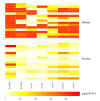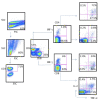Pattern recognition and cellular immune responses to novel Mycobacterium tuberculosis-antigens in individuals from Belarus
- PMID: 22336002
- PMCID: PMC3305616
- DOI: 10.1186/1471-2334-12-41
Pattern recognition and cellular immune responses to novel Mycobacterium tuberculosis-antigens in individuals from Belarus
Abstract
Background: Tuberculosis (TB) is an enduring health problem worldwide and the emerging threat of multidrug resistant (MDR) TB and extensively drug resistant (XDR) TB is of particular concern. A better understanding of biomarkers associated with TB will aid to guide the development of better targets for TB diagnosis and for the development of improved TB vaccines.
Methods: Recombinant proteins (n = 7) and peptide pools (n = 14) from M. tuberculosis (M.tb) antigens associated with M.tb pathogenicity, modification of cell lipids or cellular metabolism, were used to compare T cell immune responses defined by IFN-γ production using a whole blood assay (WBA) from i) patients with TB, ii) individuals recovered from TB and iii) individuals exposed to TB without evidence of clinical TB infection from Minsk, Belarus.
Results: We identified differences in M.tb target peptide recognition between the test groups, i.e. a frequent recognition of antigens associated with lipid metabolism, e.g. cyclopropane fatty acyl phospholipid synthase. The pattern of peptide recognition was broader in blood from healthy individuals and those recovered from TB as compared to individuals suffering from pulmonary TB. Detection of biologically relevant M.tb targets was confirmed by staining for intracellular cytokines (IL-2, TNF-α and IFN-γ) in T cells from non-human primates (NHPs) after BCG vaccination.
Conclusions: PBMCs from healthy individuals and those recovered from TB recognized a broader spectrum of M.tb antigens as compared to patients with TB. The nature of the pattern recognition of a broad panel of M.tb antigens will devise better strategies to identify improved diagnostics gauging previous exposure to M.tb; it may also guide the development of improved TB-vaccines.
Figures





Similar articles
-
Differential cellular recognition pattern to M. tuberculosis targets defined by IFN-γ and IL-17 production in blood from TB + patients from Honduras as compared to health care workers: TB and immune responses in patients from Honduras.BMC Infect Dis. 2013 Mar 6;13:125. doi: 10.1186/1471-2334-13-125. BMC Infect Dis. 2013. PMID: 23497342 Free PMC article.
-
In vitro cellular immune responses to complex and newly defined recombinant antigens of Mycobacterium tuberculosis.Clin Exp Immunol. 2004 Oct;138(1):139-44. doi: 10.1111/j.1365-2249.2004.02609.x. Clin Exp Immunol. 2004. PMID: 15373916 Free PMC article.
-
Customized MHC Class I & II restricted peptides from clinical isolates of Mycobacterium tuberculosis tweak strong cellular immune response in Healthy individuals and Pulmonary Tuberculosis patients: A potential candidate in vaccine design.Tuberculosis (Edinb). 2025 May;152:102640. doi: 10.1016/j.tube.2025.102640. Epub 2025 Apr 15. Tuberculosis (Edinb). 2025. PMID: 40262464
-
[Evolution of IGRA researches].Kekkaku. 2008 Sep;83(9):641-52. Kekkaku. 2008. PMID: 18979999 Review. Japanese.
-
Immunogenic potential of latency associated antigens against Mycobacterium tuberculosis.Vaccine. 2014 Feb 3;32(6):712-6. doi: 10.1016/j.vaccine.2013.11.065. Epub 2013 Dec 2. Vaccine. 2014. PMID: 24300592 Review.
Cited by
-
A broad profile of co-dominant epitopes shapes the peripheral Mycobacterium tuberculosis specific CD8+ T-cell immune response in South African patients with active tuberculosis.PLoS One. 2013;8(3):e58309. doi: 10.1371/journal.pone.0058309. Epub 2013 Mar 26. PLoS One. 2013. PMID: 23555576 Free PMC article. Clinical Trial.
-
Utility of host markers detected in Quantiferon supernatants for the diagnosis of tuberculosis in children in a high-burden setting.PLoS One. 2013 May 15;8(5):e64226. doi: 10.1371/journal.pone.0064226. Print 2013. PLoS One. 2013. PMID: 23691173 Free PMC article.
-
Potential of immunomodulatory agents as adjunct host-directed therapies for multidrug-resistant tuberculosis.BMC Med. 2016 Jun 15;14:89. doi: 10.1186/s12916-016-0635-1. BMC Med. 2016. PMID: 27301245 Free PMC article. Review.
-
Sonic hedgehog-dependent induction of microRNA 31 and microRNA 150 regulates Mycobacterium bovis BCG-driven toll-like receptor 2 signaling.Mol Cell Biol. 2013 Feb;33(3):543-56. doi: 10.1128/MCB.01108-12. Epub 2012 Nov 19. Mol Cell Biol. 2013. PMID: 23166298 Free PMC article.
-
Immune responses in the treatment of drug-sensitive pulmonary tuberculosis with phenylbutyrate and vitamin D3 as host directed therapy.BMC Infect Dis. 2018 Jul 4;18(1):303. doi: 10.1186/s12879-018-3203-9. BMC Infect Dis. 2018. PMID: 29973153 Free PMC article.
References
-
- Titov LP, Zakerbostanabad S, Slizen V, Surkova L, Taghikhani M, Bahrmand A. Molecular characterization of rpoB gene mutations in rifampicine-resistant Mycobacterium tuberculosis isolates from tuberculosis patients in Belarus. Biotechnol J. 2006;1(12):1447–1452. doi: 10.1002/biot.200600153. - DOI - PubMed
-
- Grishko AN, Grashchenkova OV, Knoring BE, Gul'el'mi LA, Isaeva N, Petrova LI, Klepatskaia SB, Parmon VM. [Characteristics of prevention of tuberculosis in the conditions of low prevalence of tuberculous infection] Probl Tuberk. 1992;7-8:6–8. - PubMed
-
- Bubochkin BP, Ivanova ES. Specific prevention of tuberculosis in young patients by BCG vaccine. Probl Tuberk. 1991;3:16–19. - PubMed
MeSH terms
Substances
LinkOut - more resources
Full Text Sources
Other Literature Sources

